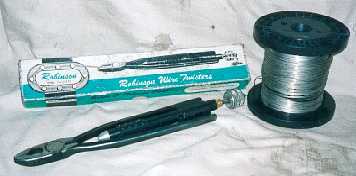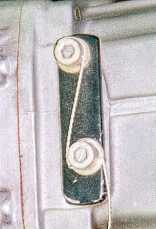LOCKWIRE
Lockwire is a method of securing bolts. Wire is passed through a hole
drilled in the bolt head and then twisted and attached to another bolt head
or a hole drilled in the piece being bolted. Lockwire will not prevent the
bolt loosening the small amount where residual stress is lost. But it will
prevent the fastner loosening completely and falling out. Also if the bolt
breaks it should prevent the fastner falling out and the loose head creating
havoc where ever it should fall.

Lockwire Pliers and Wire.
The tools of lockwiring. The pliers are special. They self lock and the knob at the base of the handles is pulled out and causes the pliers to rotate, twisting the wire. The wire is generally stainless steel. My pliers are made by Robinson and were some of the most expensive on the market but after using some cheap ones I would say they are worth every pound. The cheap ones nicked the wire when clamping and kept coming unclamped when twisting.

Example of Lockwire.
The above picture is
an example of lockwire. Holes are drilled in each bolt head and the wire is
twisted and positioned so as to tighten the bolts. Drilling the holes in the
bolt heads can be awkward. A good centre punch is required and the bolt must
be clamped securely in a drill vice and the hole drilled on a pillar drill.
Use the appropriate speed (about 2,200 rpm for a 2mm diameter drill) and lubricant.
A cobalt drill will make the job easier. Ensure you deburr the hole and chamfer
both sides.
When wiring the idea is to get the wire tight by pulling it before twisting,
not to get the wire tight by excessive twisting. Practice makes perfect and
often did each job 2 or 3 times initially before I was satisfied.
Alternatives
With chemical locking methods (Loctite etc.) becoming more advanced the
use of lockwire is now less common, but each method has its merits and it
is up to us to decide which is most appropriate.
Further Reading
Read Nuts, Bolts, Fastners and Plumbing Handbook by Carroll Smith.